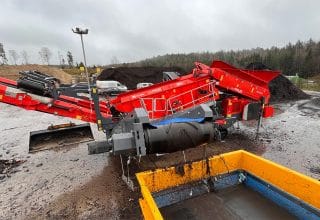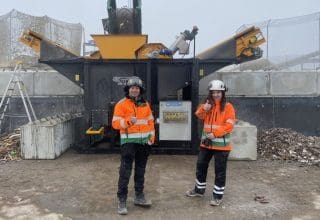Here are some common methods to choose from:
Stabilizing soils
Clayey and unstable soils can be a major problem in construction projects. Digging out the unstable soil, excavating it and later filling it with stabilized masses takes a lot of time and is usually very costly. The same applies if you instead choose to use piling to stabilize the soil.
screen with a lime blender
A much more time and cost effective way of dealing with unstable soils is to use a screen with lime mixes. Depending on the properties of the soil, a method can be chosen whereby the unstable soil is excavated and screened through Backer's 3-fraction star sieve. The material is quality assured as the overgrown material is sorted out and the fine fraction, about 0-40mm, goes directly into the lime mixer on the machine, whereupon the stable mass is ready for use. The lime-enriched soil can then be spread on a larger flat surface, which after irrigation hardens and becomes more durable for e.g. asphalting.
screen and mixers
Another common method is to feed the lime-infused soil into a concrete truck/mixer directly from the sorting plant's discharge bath and add water. This procedure produces a runny mass that begins to "burn" within 24 hours and is then stable. The runny mass can be used to stabilize the soil around water and sewage pipes, or to make lime columns in soils with a lot of clay. Everything is done in the same place where the soil was first excavated and no mass has to be transported away to be prepared for production.
Washing of soils
The process of washing soils can vary depending on the type and degree of contamination. Here are some common steps that can be included in a washing process:
- Dividing the soil: If the soil contains larger contaminants or objects, it can first be crushed or screened to achieve a more uniform particle size and facilitate the process.
- Water washing: Water is added to the contaminated soil and mixed thoroughly to release and dissolve the contaminants. This can be done by spraying or flowing the water through the soil.
- Separation: After the washing process, the water passes through the soil and the pollutants are dissolved and mixed with the water. The contaminants are then separated from the water by various methods, such as sedimentation, flotation, filtration or chemical processes. Several separation steps may be required to remove different types of pollutants.
- Wastewater treatment: The water used for washing the soil can contain high concentrations of pollutants and must be treated before it can be released into the environment. Advanced treatment methods such as chemical treatment, evaporation, ion exchange or activated carbon can be used to purify wastewater and restore it to more environmentally friendly levels.
It is important to note that soil washing can be a complex process and requires careful planning and management of both the soil and the wastewater to avoid further contamination or environmental impacts. Furthermore, the effectiveness and suitability of the washing method may vary depending on the contaminants in the soil and the specific requirements and regulations for waste management in different areas.
Options for recycling soils
Mechanical sorting
This involves using mechanical processes to sort the soil based on size, shape or density. It can include the use of wind sifters and screen to separate the soil into different fractions.
Sedimentation and flotation
This involves using differences in particle size and density to separate soil materials. By allowing the soil to stand still in a container or basin, particles of different densities can sink or float upwards, allowing them to be separated. Flotation is used to separate contaminated particles from the soil by exploiting differences in the hydrophobicity of the particles. By mixing the soil with water and adding flotation additives, some particles can float to the surface and be removed.
Magnetic separation
If the soil contains magnetic contaminants, magnetic separation can be used. By using magnets, magnetic particles can be separated from the surrounding soil.
Combined methods
Often a combination of different methods is used to achieve efficient sorting and recycling of soils. For example, mechanical sorting can be combined with sedimentation or magnetic separation to improve the efficiency and accuracy of the recycling process.



